LTE-M - Technology for mobile IoT projects

LTE-M (also LTE-MTC / LTE Cat-M1/2)
LTE-M is the abbreviation of LTE technology for Machine-type Communications. The standard is based on 3GPP specifications and thus on technology building blocks from 4G and 5G. The 3rd Generation Partnership Project (3GPP) creates globally valid standards for data transmission and has thus also defined the LTE standard. In comparison between Low Power Wide Area Networks (LPWAN) LTE-M is recommended for the transmission of high data rates. Up to 7 Mbit/s in the uplink (from the sensor to the network) and up to about 4 Mbit/s in the download (from the network to the sensor) are possible. However, transmission requires a wider frequency band than NB-IoT: LTE-M devices typically support bandwidths between 1.4 and 5 MHz.
The special designation of LTE-M with a maximum bandwidth of 1.4 megahertz is LTE Cat-M1. In the assigned frequency spectrum, LTE-M can also transmit data between the IoT devices through walls or lower-lying rooms. The building penetration of the signals is very high over long distances in the communication network. Thus, LTE-M is particularly recommended for IoT applications where ordinary cellular networks run dry in a dead zone and network coverage is no longer guaranteed. In addition, the latencies in the wireless network are significantly lower when transmitting via LTE-M. Mobility is another strength of this LTE coverage. Write and read speeds are similar to those of conventional, broadband mobile communications connections via 4G and 5G in the same LTE location. This means that if required, SMS or voice messages can also be transmitted with low energy consumption and high penetration (gain around 10 dB) in the upload direction.
Types of LTE-M
LTE-M: Greater bandwidths for stationary and mobile IoT applications
LTE-M is the abbreviation for Long Term Evolution for Machines. With the introduction of this standard, the general usability of IoT systems was decisively expanded. The complementary service has been optimized for the transmission of data. With the ongoing network rollout, LTE-M is manifesting itself in the industrial sector worldwide as a future-proof alternative for older mobile technologies. 2G and 3G have already been switched off in some countries or will no longer be available in the coming years. As a result, LTE-M has established itself as a service with low frequency spectrum in many places alongside narrowband IoT (NB-IoT) in the communications network. Both standards are supported by leading telecommunications bodies and mobile network operators and benefit from global network coverage. This ensures the most important feature of LTE-M.
Keyword: mobility. In end-to-end processes with business customers, mobile IoT applications with larger bandwidths, or data volumes, are necessary. For example, when the provider has to install a new firmware update on the connected IoT devices. For this purpose, the service uses the benefits of LTE coverage as well as current encryption methods to make the data transmissions between the devices unreadable for third parties. Another benefit is the entire tracking of IoT devices in use. Using signal transmission in LTE-M, a transmitter in a transport container can report where it is at regular intervals - smart tracking. Another use case is health trackers that report important data on the health of its owner to a central location at fixed times - e-Health. The mobility factor makes LTE-M the ideal standard for IoT solutions in which movement plays a fundamental role:
- Wearables
- e-health sensors
- asset tracking
- Smart city applications with higher data volumes (e.g., traffic monitoring)
- Alarm and security systems
- Remote control and predictive maintenance of machines
- Smart factory (and smart home) applications
LTE-M modules: The standard in its operational application
NB-IoT and LTE-M: Two standards for stationary and mobile service
Low bandwidth, low power consumption, good building penetration and long range - with these benefits, LTE-M and Narrowband-IoT will become the standard for IoT applications in 4G and 5G. Both standards are tightly interwoven with existing mobile networks. In addition, both services are a component of the specifications for 5G mMTC implementations envisioned in the future. Embedding them in cellular standards makes the investment in LTE-M or narrowband IoT future-proof - regardless of your choice.
In direct comparison, the different benefits of LTE-M and Narrowband-IoT are obvious. **NB-IoT is recommended for stationary monitoring of IoT devices and IoT applications due to its transmission structure. In smart parking, a parking sensor reports whether the parking space is free via NB-IoT. A typical use case in the smart city. With lower latency and higher bandwidth, LTE-M, on the other hand, is perfect for mobile use - for example, in smart tracking of vehicles, packages and their respective delivery status within complex logistics centers.
Based on existing hardware components grandcentrix creates customized solutions for your IoT applications and business models in the Internet of Things. Especially in narrowband IoT we see ourselves as a specialist for connectivity of highly individualized solutions with complex connectivity requirements. Since 2010, we have been implementing your customer-specific IoT projects with over 200 employees from Cologne. In addition, our solution portfolio for NB-IoT has grown strongly since 2020 in the Vodafone group.
| Term | Definition |
|---|---|
| 3GPP | 3rd Generation Partnership Project (3GPP) is a worldwide cooperation of standardization committees for standardization in mobile communications; specifically for UMTS, GSM, LTE and 5G/NR. |
| LTE-M | LTE-M or LTE-Cat-M1 stands for LTE for Machines and is also known as Enhanced Machine-type Communications, or eMTC for short. It is a supplementary 3GPP standard (Release 13) for LTE. It enables an LTE network operator to equip its mobile network for typical applications in the Internet of Things (IoT). |